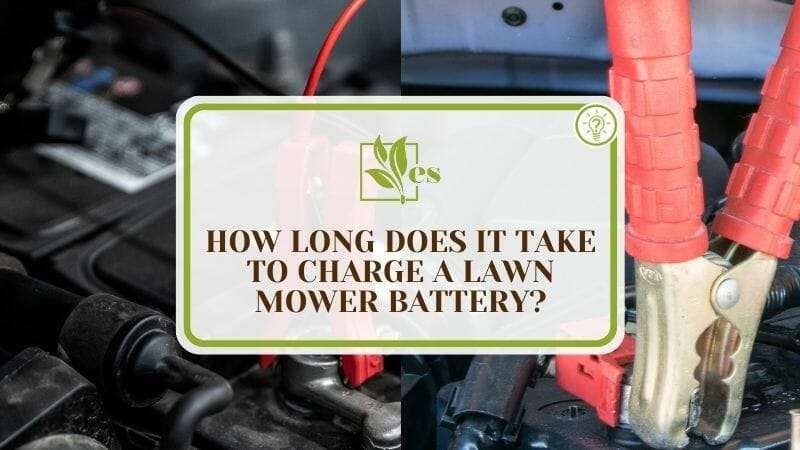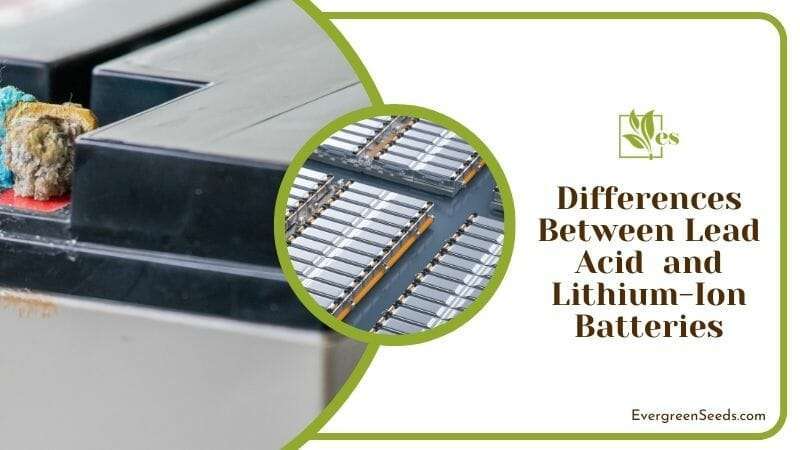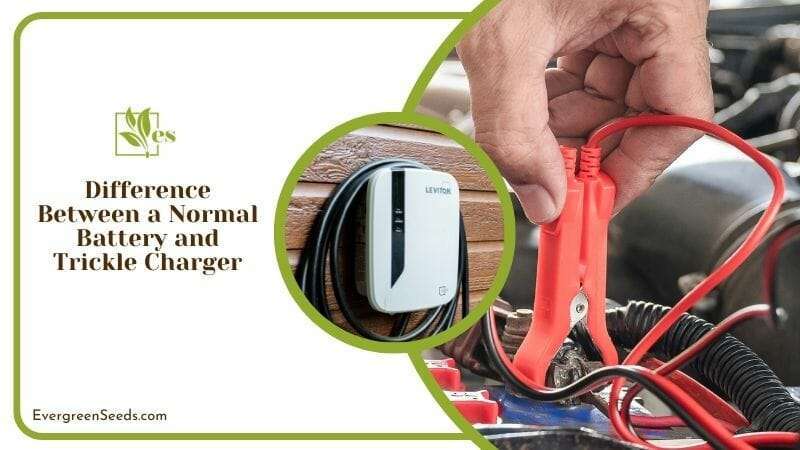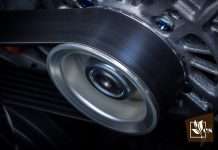- Giant Green Arborvitae Spacing: All There Is To Know Regarding This - March 31, 2024
- 7 Fruit Trees for Zone 9: The Perfect Fruit Garden - March 30, 2024
- How To Revive a Dying Avocado Tree: 9 Best Steps To Follow - March 30, 2024
How long does it take to charge a lawn mower battery is a very good question commonly asked by mower owners.

It can potentially be as little as 25 minutes and as much as 240 minutes! It can be a tricky thing to understand the charging time of a lawn mower battery, so read on to learn more!
JUMP TO TOPIC
What Is the Battery Charging Time of Your Lawn Mower?
💥The battery charging time of your electric lawn mower largely depends on its model specifications – it can be 25 minutes all the way up to 240 minutes. While there are many brands out there, they do have similarities when it comes to the type of lawn mower battery.
While a lawn mower itself can be classified as a small model or a large model, the charging time is largely dependent on the size and the type of battery used. Here are some examples of the types of mowers and their charging times using lithium-ion batteries. If your mower does not have a battery and you have issues with its air filter or with oil coming out from its exhaust, check out our solution guide.
Types of Mowers
A small push mower with a lithium-ion battery can take 30 minutes to charge and operate for around the same time. A small light mower with the same battery type will take around 90 to 120 minutes in order to function for 45 minutes. On the other hand, it takes 240 minutes to power up a small sit-on mower for 60 minutes.
Big self-propelled mowers need 120 minutes to charge on a 50-minute operation time. A big sit-on mower, however, takes almost twice the time at 240 minutes in order to function for 90 minutes.
Battery Charger and Output
It should be noted that it is always best to look at your owner’s manual for safety guidelines when it comes to charging your lawn mower’s battery. Users should also consider that the estimated charging time depends on the battery charger and its output.
If you have a lawn mower with a rechargeable sealed lead acid battery, the charging time is different. For example, 135 minutes is how long to charge lawn mower battery 2 Amp, assuming your battery is 6-Volt. For 12-Volt batteries, it takes 1,800 minutes to charge at 2 Amp.
Now, 45 minutes is how long to charge lawn mower battery 6 Amp for a 6-Volt, 4.5 Ah battery. For the 12-Volt, 35 Ah version, it takes 345 minutes to charge at 6 Amp.
At 10 Amps, a 6-Volt, 4.5 Ah battery needs 25 minutes while one at 40 Amps only needs 5 minutes. For a 12-Volt 35-Ah battery, it takes 210 minutes at 10 Amps and 50 minutes at 40 Amps.
If you are wondering how long to charge a lawn mower battery at 40 Amps, it takes around 5 minutes for a 6-Volt battery and around 50 minutes for a 12-Volt one. Older lawn mowers, especially before and leading up to the 1980s, function on a 12-Volt battery. Newer models are usually powered by a 12-Volt battery.
For users asking, “Can you charge a lawn mower battery with a 12-Volt charger?” You definitely can, as long as your battery is also a 12-Volt one. Now, if you charge a 6-Volt battery with a 12-Volt charger, you run the risk of running the battery dry and creating a dangerous heating issue.
Users should always remember that these are estimates and do not represent a set period of time. As always, it is best to consult the owner’s manual for the appropriate charging time for your specific lawn mower model.
What are the Differences Between Lead Acid Battery and Lithium-ion Batteries?
The differences between lead acid battery and lithium-ion batteries lie in their lifespan, their time to charge, and their level of safety. Lithium-ion batteries charge more quickly than lead acid ones. These are the two types of batteries found in lawn mowers these days.
Lead acid batteries tend to be found in older models while lithium-ion batteries are typically installed in the newer mowers. Here are the most basic differences between the two types of batteries.

Lead acid batteries have a shorter lifespan and requires regular maintenance, but they cost less. These types of batteries can take more time to charge to full capacity, and can cause damage to the user or to the unit through gas emissions.
On the other hand, lithium-ion batteries have a longer lifespan and higher efficiency, but can cost more. They can charge quickly unless the battery is damaged, and new lithium-ion batteries rarely heat up or explode.
What Does Trickle Charging Your Lawn Mower Battery Mean?
The trickle charge method means that you can charge it for longer if you are Powering the battery of a lawn mower through this method. This type of charger provides batteries with low-voltage charging that is intended to improve the battery life and reduce the risk of overcharging.
However, just because you can leave it on longer does not mean that you should leave it on for more than what is recommended. Left unattended and on too long, this type of charger can lead to overheating. Oftentimes, this leads to two results. One is a dead battery, and the other is the battery catching fire and exploding.
What is the Difference Between a Normal Battery Charger and Trickle Charger?
The difference between a normal battery charger and a trickle charger is that a regular charger for batteries is designed to provide a high constant voltage to the battery. This allows the battery to charge faster. Trickle chargers, on the other hand, deliver a slower amount of charge.
Usually, trickle chargers operate at two Amps, extending the charging time to several hours longer. This makes trickle chargers ideal if you plan to leave your lawn mower batteries to charge for extended periods of time.

Trickle chargers provide a current that counteracts the battery’s self-discharge rate in order to keep it plugged in fully charged. The low Amp output can maintain the battery charge level but is not the best option to quickly charge the battery to full capacity.
How Do You Charge Your Lawn Mower Battery?
To charge your lawn mower battery, you need to first of all follow safety protocols; you should check for possible damage, look for the battery in the mower, connect the cables, allow the battery to rest, disconnect the charger, and reinstall the battery when you are done.
– Follow Safety Protocols
This includes using the correct tools, equipment, and machine aside from wearing personal protective clothing.

As much as possible, read through the owner’s manual for the specifics on charging the batteries of your lawn mower unit.
– Check for Possible Damage
Inspect your lawn mower for signs of damage, such as loose wires, leaks, and other concerns. This will help you anticipate any possible issues.
– Look for the Battery
The location of the battery is entirely dependent on the make and model of the lawn mower.

Although, most have their batteries hidden under the seat. The user’s manual will help you locate the battery quickly. Avoid charging bloated batteries as it can catch fire or explode.
– Connect the Cables
Once the battery has been found, look for the red charge cable first and connect it to the positive battery terminal. Next, the black cable should be connected to the negative battery terminal.
This will start the charging process. Do not switch the order of the red and black cable connection to prevent any malfunction.
– Allow the Battery To Rest Before Disconnection
Lead acid batteries usually produce gases while charging and these gases can damage you or your mower. Once charged, wait around five minutes for the gases to disperse, and then detach the charger cables.
For lawn mowers with lithium-ion batteries, this step can be disregarded.
– Disconnect the Charger
To safely unplug the charger from the wall socket, disconnect the black or negative charger cable first. Next, disconnect the red or positive charger cable from the battery.

– Reinstall the Battery
Place the battery in the allocated housing of the lawn mower. Connect the positive terminal first before the negative.

– Maintain the Overall Health of Your Lawn Mower Battery
You can maintain the overall health of your lawn mower battery by always using them as specified, matching the battery to the correct charger, and not overcharging them. The batteries found in your lawn mower can vary, especially when you compare old ones versus new ones.
Here are some tips for you to consider.
- In terms of voltage, most modern lawn mowers incorporate sealed 12-Volt lead acid batteries.
- Older models sometimes use 6-Volt batteries, so always check your battery.
- Match the battery type to the appropriate charger.
- Generally, 10 Amps is the maximum output for most lawn mower chargers.
- Look for battery chargers with additional features, such as battery lifespan extension or improved charging convenience and safety.
- Another feature to look for is a jumpstart setting that can bring new life to a dead battery.
- To fully charge your batteries safely, look for a charger with an automatic charging shut-off.
- Additionally, try to look for chargers that offer hookup failsafe, changeable Amp rates, and built-in charging timers.






